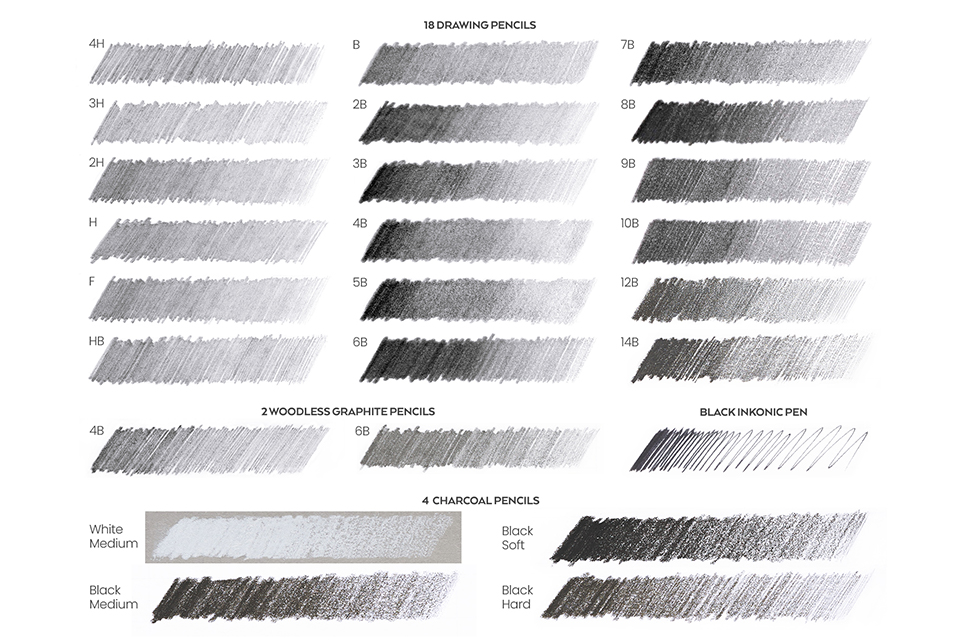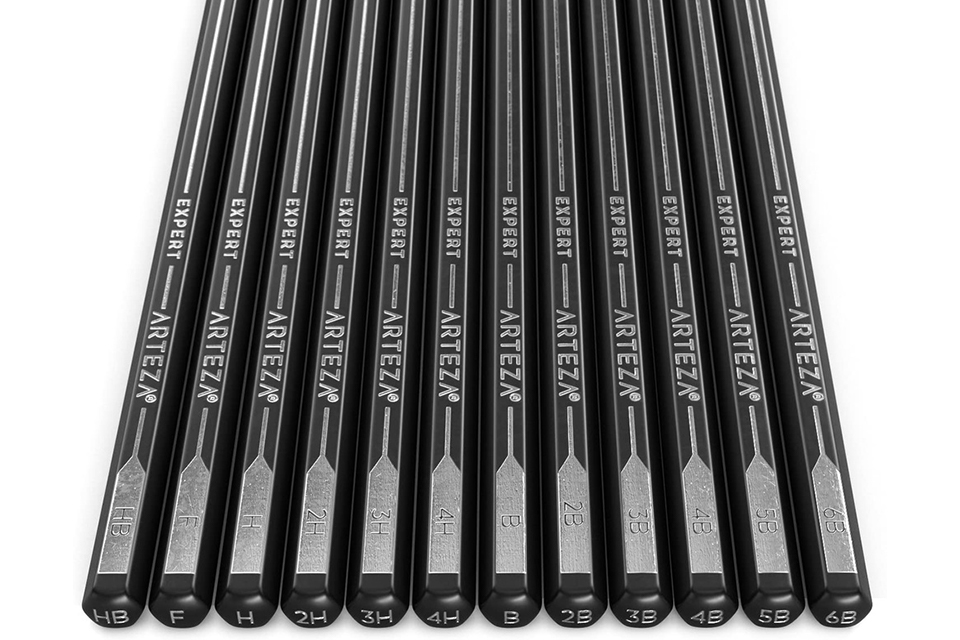Table of Contents:
- Everything You Need to Know About Pencil Lead Hardness
- A Closer Look at Pencil Lead
- What Does H & B Mean?
- How Are Drawing Pencils Numbered?
- When to Use Which Pencil
- How to Choose Professional Pencils
Everything You Need to Know About Pencil Lead Hardness
Drawing is one of the few art practices you can do with the least amount of art supplies. All you really need is a pencil and a piece of paper. And, although the common #2 pencil we’ve all used in school is sufficient to make great drawings, if you want to create the most realistic and nuanced drawings you can, then it’s important to use pencils in a variety of lead hardnesses. If you’ve never explored all the possibilities that professional drawing pencils offer, then get ready to be amazed! In this article, you’ll discover the huge impact that can be made when using pencils in different lead hardnesses.
A Closer Look at Pencil Lead
The core or lead inside your pencil is actually a mix of finely ground graphite and clay filler. This is what makes your lines, shapes and squiggles. Known as the pencil’s lead, graphite comes in varying degrees of solidity or pencil hardness. These degrees are known as the graphite scale and allow the artist to choose at a glance the right pencil for the kind of line or mark they wish to make.
What Does H & B Mean?
The first thing that’s important to know is that the hardness of the lead is divided into two categories—H and B. H stands for hard and B stands for blackness. H, or hard, leads are tightly compacted and contain more filler, which causes them to make the lightest lines, as only a tiny amount of graphite is released when the pencil is used. It takes a lot of pressure to make a darker line with pencils in the H category. At the other end of the pencil hardness scale is the B category. The graphite in these pencils has not been compacted as tightly and doesn’t contain as much filler and so they are softer, causing more graphite to come off the pencil as you draw. Because you get more graphite, your mark will be darker and it doesn’t take very much pressure to create very dark lines.

How Are Drawing Pencils Numbered?
Within each category, the hardness or softness of the lead is determined by numbers on a scale. To make it easier to understand, let’s start at the center of the scale. There you will find the HB pencil. You can think of it as the “Goldilocks pencil” —not too hard, not too soft, but just right. It is the closest thing to an equal mixture you’ll get. Left of center is where you’ll find the H category and right of center is where the B category starts. Within both categories, you have numbers that designate their density.
Let’s look at the H category first. As the pencils proceed from the center, or HB, pencil to the left, they get lighter. Therefore, as the number increases, so too, does the density, making each subsequent pencil lighter and lighter. The first pencil in this category is the one right next to the HB. It is considered the number one H pencil but is designated as simply H, without a number. The next pencil is a 2H, then 3H, 4H and so on, up to 6H.
Now for the B category. This category proceeds from the center to the right, getting darker as the numbers progress. As the number increases, so too, does the softness of the lead, making each subsequent pencil darker and darker. The first pencil in this category is the one next to the HB, and is considered the number one B pencil. It is designated as simply B. The next pencil is a 2B, then 3B, 4B and so on, up to as high as 12B.
Although 12B is considered a very dark pencil, you can actually get a darker mark with charcoal pencils. Charcoal is substantially darker and flakier than graphite. Many artist love it for its ability to be smeared or smudged in a way that graphite can’t.
When to Use Which Pencil
The best way to discover which pencil is best for which situation is to experiment with them. For simple sketching, the HB pencil is probably the most popular, with artists also favoring the H and the B pencils. For preliminary sketches that will be used as a guide for a painting or illustration, the lighter 2H–4H pencils are ideal. These pencils allow you to draw your initial composition and erase it if necessary without damage to your paper or canvas. Very light pencils, such as 6H, are also preferred for making the preliminary sketches for watercolor painting as they won’t show through the paint. The higher numbered B pencils can accomplish a range of dark values for adding shadows and contrast within a drawing. For highly complex and realistic drawings, an artist will use pencils in all grades. While the softer B pencils (6B and up) are generally considered the best for shading, there's no reason to discount the harder H pencils, since everyone applies pressure to their pencils differently.
How to Choose Professional Pencils
If you’re serious about taking your drawings to the next level, there are several ways to choose professional-grade pencils. Although they can be purchased separately, the best way to begin is to buy a set that includes the different grades. You can buy sets that have just a few of these or larger ones that have a complete range of lead hardnesses. The great thing about professional pencil sets is they allow you to try out all the leads in different ways within your own drawing. What works for another artist may not work for you, but by having several pencils to choose from you’ll be able to find the ones you like best.
Some sets also include additional drawing tools including charcoal, erasers, pencil sharpeners and blending stumps. Most come in sturdy metal or plastic cases, making them easy to transport and protected from damage.
Professional sets aren’t limited to graphite pencils. You can also find sets of colored pencils, too. Although they aren’t graded by lead hardness, they’re still fun to use and can enhance your black and white drawings immensely!
To complement your set, we recommend you have a sketchbook or a pad of drawing paper. There are tons of different types of books and pads, including ones that are hardbound, spiral-bound, rectangular or square. Books and pads made especially for pencil drawing will ensure that your drawings stay clean and neat and look their best. Some even come with micro-perforated pages that you can easily tear out after completion for displaying or sharing with others.
For more information about pencil sets and drawing techniques, we suggest you check out one of these blogs.
Drawing Pencil Set with Everything You Need

There you have it. Now that you understand the importance of knowing about pencil lead hardness, you’re ready to get started. Everything around you is a potential subject for your drawing. Look around, go for a walk or sit in your favorite cafe or park and just start drawing. Soon you’ll find that the act of recording what you see and using a variety of pencils to capture the light, volume and depth of your surroundings will be one of the most relaxing and enjoyable activities you can do!
















